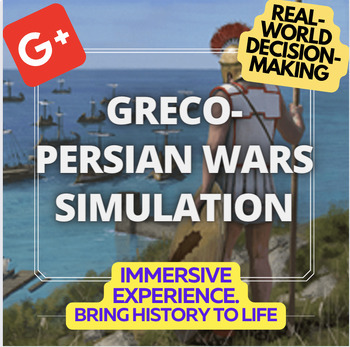Greco-Persian Wars Simulation
- Word Document File
What educators are saying
Description
Hi, friends and welcome!
I'm so excited to share this resource with you!! This is my immersive, real-world, hands-on Greco-Persian-War Simulation. This simulation is designed to engage students in a hands-on learning experience where they can analyze historical events and make strategic decisions based on the circumstances of the Greco-Persian War. By immersing themselves in the conflict and its challenges, students will develop critical thinking skills, teamwork, and an understanding of the complexities of warfare.
To learn more about my simulations and their structure, please watch this short video here.
In essence, students are placed into small groups and have to make real-world and historical decisions, including:
1) · Your group has been assigned the role of the Greek city-states defending the pass of Thermopylae against the advancing Persian army led by King Xerxes. The Greek city-states are heavily outnumbered and face the challenge of holding the narrow pass to prevent the Persians from invading further into Greece.
2) · Your group represents the Athenians during the Battle of Salamis, a naval conflict between the Greek city-states and the Persian fleet. The Athenians must make critical decisions to confront the Persian naval forces and secure a victory that could potentially change the outcome of the war.
3) · Your group represents the city of Athens during the siege by the Persian army. The city is under threat of invasion, and the Athenians must make critical decisions to defend their city and ensure its survival.
4) · Your group represents the Greek city-states during the Battle of Plataea, a decisive land battle against the Persian army. The Greeks must make critical decisions to confront the Persians and secure a victory that could potentially end the war.
The simulation ends with a thorough debrief section about what actually happened in history.
I love to engage my students in simulations because they provide a dynamic and immersive learning experience that goes beyond the pages of a textbook. By stepping into the shoes of historical figures and making decisions, students develop a deeper understanding and empathy for the challenges, complexities, and human stories of the past. My simulation foster critical thinking skills, encourage teamwork and collaboration, and allow students to explore different perspectives and outcomes. Through such interactive experiences, students forge a deeper engagement with history, realizing that the decisions made by individuals and societies in the past have far-reaching consequences that shape the present and future.
This resources includes 11-pages of content:
- Clear instructions for the teacher
- Ample context about the Greco-Persian Wars
- Scenario sheets for students



